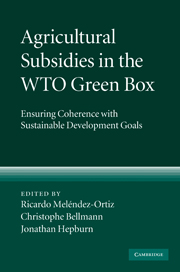Book contents
- Frontmatter
- Contents
- List of contributors
- Preface
- Acknowledgements
- List of abbreviations
- 1 Overview
- PART I The recent evolution of agricultural trade policy reform
- 2 The historical context of the green box
- 3 Doha Round negotiations on the green box and beyond
- 4 The reform of the EU's Common Agricultural Policy
- 5 Farm policy reform in the United States: past progress and future direction
- 6 Agricultural trade policy reform in Japan
- PART II The focus, extent and economic impact of green box subsidies
- PART III Green box subsidies and developing countries
- PART IV Green box subsidies and the environment
- PART V Looking forward: how can change take place?
- Appendix: Text of Annex 2 of the WTO Agreement on Agriculture (“the green box”)
- Index
- References
4 - The reform of the EU's Common Agricultural Policy
from PART I - The recent evolution of agricultural trade policy reform
Published online by Cambridge University Press: 03 May 2010
- Frontmatter
- Contents
- List of contributors
- Preface
- Acknowledgements
- List of abbreviations
- 1 Overview
- PART I The recent evolution of agricultural trade policy reform
- 2 The historical context of the green box
- 3 Doha Round negotiations on the green box and beyond
- 4 The reform of the EU's Common Agricultural Policy
- 5 Farm policy reform in the United States: past progress and future direction
- 6 Agricultural trade policy reform in Japan
- PART II The focus, extent and economic impact of green box subsidies
- PART III Green box subsidies and developing countries
- PART IV Green box subsidies and the environment
- PART V Looking forward: how can change take place?
- Appendix: Text of Annex 2 of the WTO Agreement on Agriculture (“the green box”)
- Index
- References
Summary
Introduction
From its inception in the 1960s through to the early 1990s, the European Union's common agricultural policy (CAP) was little changed. The archetypal CAP tried to raise farm incomes through market price support mechanisms – involving variable import levies, intervention buying, export subsidies, etc. – as described in Harris, Swinbank and Wilkinson (1983). Structural policy was barely developed: in 1988 it amounted to only 5.1 per cent of budgeted spend on market price support, for example (Commission, 1989: T/83). For most Member States the purpose of ‘structural policy’ was to aid the modernisation of European agriculture, or to provide additional support in marginal areas. Paying farmers to produce (or manage) countryside was a relatively novel idea when in 1985 – largely on UK urging – Member States were authorised to grant EU subsidies to farmers in environmentally sensitive areas ‘in order to contribute towards the introduction or continued use of agricultural practices compatible with the requirements of conserving the natural habitat and ensuring an adequate income for farmers’ (Potter, 1998: 84, directly quoting the EU regulation).
Two decades later, the CAP is rather different. In the context of this chapter, exploring the EU's use of the WTO's green box, there have been two changes. First, there has been a significant decoupling of the support designed to sustain farm incomes and, second, there has been an attempt to switch support from agriculture to the wider rural economy and to protection and enhancement of the environment (from the so-called Pillar 1 to Pillar 2, to use the EU's jargon).
- Type
- Chapter
- Information
- Agricultural Subsidies in the WTO Green BoxEnsuring Coherence with Sustainable Development Goals, pp. 70 - 85Publisher: Cambridge University PressPrint publication year: 2009
References
- 1
- Cited by



